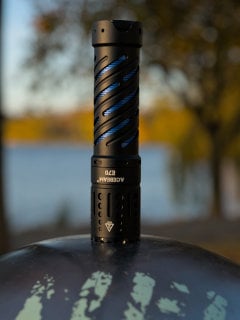And, any idea how to use them? 3 pins is perplexing.
Wrong stuff removed
AAAAH I LOVE YOU FLASHLIGHT LOVING BASTARDS
Seriously every time this group crosses my feed it makes me so goddamn happy. You guys and you’re incredible niche little love that you know so much about I fucking love it
Nope.
UPDI used on Atmel micros on Anduril capable flashlights uses a single line for debug and flashing. Much earlier than that, Motorola/Freescale/NXP Coldfire, S12, and some other MCUs used BDM which was also a single wire protocol.
If you want to flash a newer Anduril to this light, look here for hardware and procedures to use those pads.
Wow are you saying this light has updi and a t1616? Nice! I knew that the sp10 pro has that but I had thought the LT1S was older. I just checked my sp10 pro though, and sure enough, it has similar contacts. So this is welcome news. Thanks!
The programming hardware won’t help because the firmware is closed source.
You don’t need the original source to program a flashlight. If it’s ATTiny based then Anduril has your back.
I agree. If you are able to define the HW specific part of Anduril for this new model you can create a hex file and flash it.
I won’t know for sure without doing a reflash, but I think al177 has the right answer: those pads are for the UPDI system on newer AVR’s, so this is great news once I can get a UPDI dongle. My D4v2 uses an older chip and 6 contact pads. Thanks for the response though!
Aren’t most microcontrollers programmed over UART? AVR has their own one wire programming interface, but neither use clock signals.
One wire is more for just a few sensors. I think the STmicro stuff has a 1 wire option. At least one of my programmers has a label for it, but with all my hobby stuff, I’ve never used 1 wire for programming. I have only used it for a temperature sensor as far as I can recall. Everything is either JTAG or UART in my limited experience.
So there’s the OneWire protocol that’s for sensors, different microcontrollers will implement a programming protocol using a single wire, which is what I meant.
Jtag has a clock signal, but is generally 5 lines.
My point being that looking for similar trace lengths because one is a clock signal isn’t sound advice. All the common protocols either don’t use a clock signal, or are more than two lines.
Certainly looks like UPDI pads. I have update the firmware on other kinds of flashlights with similar pads. You can try to connect with a test command without trying to reflash. Here is a lot of information on the topic: https://budgetlightforum.com/t/anduril-flashlight-reflash-reference/216942
That photo doesn’t look like a Sofirn LT1S at all.
Oops you are right, I got the model designations mixed up. It is the one with 1x 21700. LT1 mini? It’s not on their site right now, I guess OOS. But I took the pic myself. I hope it comes back since it’s a nice light.
Added: I’ve edited the title, thanks for the catch!
I just checked my LT1 mini. It looks identical and I can confirm that model number 0622 is the correct firmware.
deleted by creator



